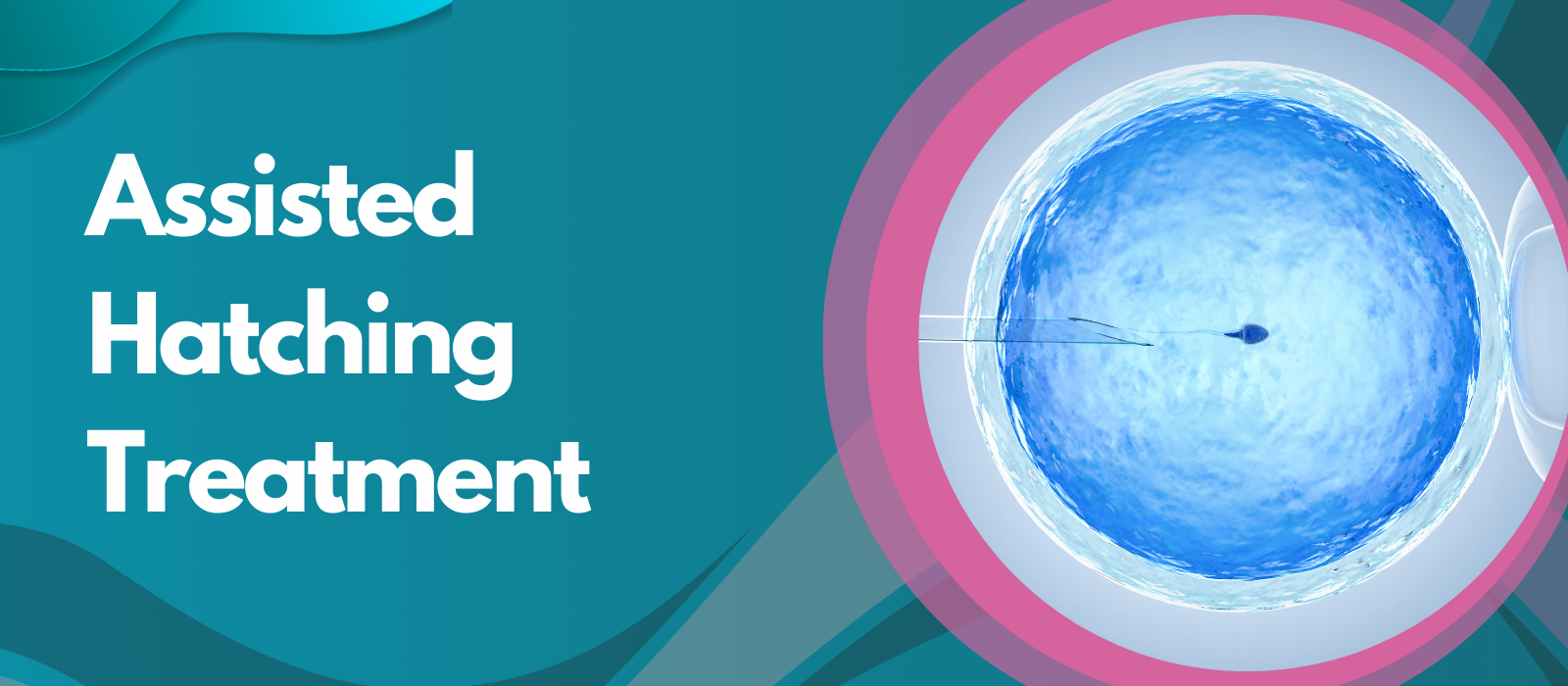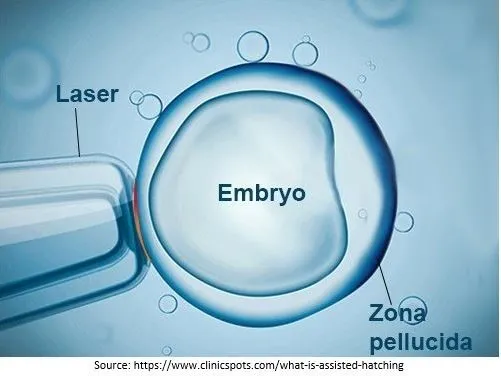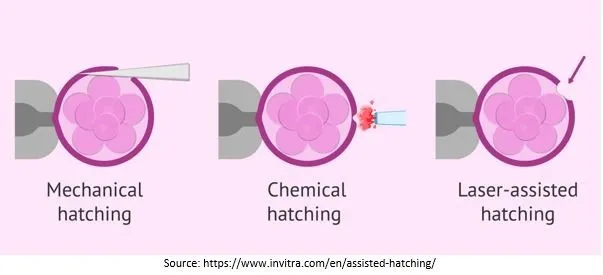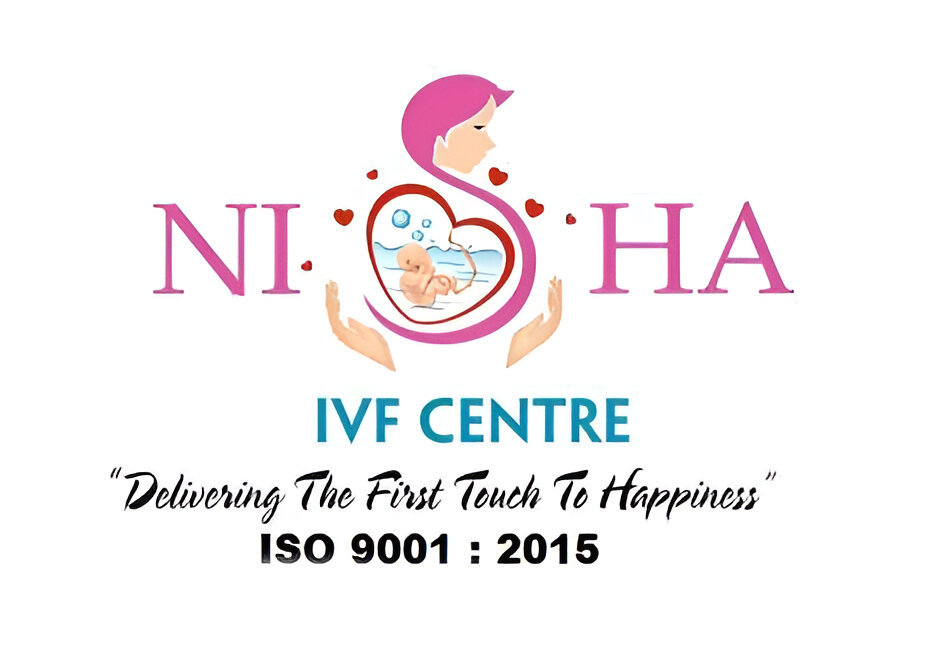
Assisted Hatching Treatment in Ahmedabad
In vitro fertilization (IVF) cycle failure is a frustrating experience for couples and individuals. It is often caused by an embryo’s inability to implant in the uterus.
If you’ve suffered a failure in more than one IVF cycle, your fertility doctor in Ahmedabad may recommend a technique known as assisted hatching. People with multiple IVF failures can opt for assisted hatching treatment in Ahmedabad.
What is Hatching in humans?
In birds and some reptiles, hatching means coming out of a biologically complete replica of that creature by breaking an outer shell. Whereas in humans, it indicates just the beginning of a long journey after the union of a male and a female gamete in the fallopian tube called fertilization.
Fertilization leads to embryo formation further; the embryo travels to the uterus. By the time it comes to the uterus, it reaches a stage called a blastocyst. The core portion of the blastocyst- the Inner Cell Mass (ICM) has to implant into the endometrium, the uterus’ inner lining, to begin forming a baby.
The process of ICM coming out through a small opening of the soft, porous, protective layer called Zona Pellucida of the blastocyst is called hatching.
What is the Assisted Hatching?

During an assisted hatching, the embryologist weakens the barrier around a fertilized embryo at a single point. A perforated zona pellucida improves the possibilities of the embryo hatching and its implantation.
In a natural pregnancy, when the embryo enters the developmental stage known as the blastocyst stage, the zona begins to thin. The thinning process is driven by repeated contracting and expanding of the blastocyst, which alters the elasticity of the zona. After the sufficient thinning of the zona, it tears, allowing the embryo to hatch.
The embryos that do not hatch will not be able to implant. Various studies have seen that natural hatchings in human blastocysts do occur near the inner cell mass.
In assisted hatching treatment in Ahmedabad, the embryologists apply the observed behavior of successful natural hatching to increase the chances of implantation for IVF patients.
Who is an ideal candidate for the Assisted Hatching?
- Patients who have experienced failure in previous IVF cycles.
- Individuals whose embryos have a thick zona pellucida.
- Women older than 35 years can benefit from assisted hatching.
What are the different methods of Assisted Hatching?

1. Mechanical hatching
The mechanical hatching method creates a cross-hatched slit in the zona. The embryologist holds the embryo with a holding pipette and utilizes a microneedle to pierce the zona to make the penetrations. After piercing, the embryo is discharged from the holding pipette.
Then, reposition it so that the zona is between the microneedle and the holding pipette. The embryologist applies gentle pressure, causing the microneedle to create a tear in the zona. The embryologist repositions the embryo and repeats the procedure, creating an opening in the zona.
2. Enzymatic hatching
Here, the embryologist dissolves the part of the zona using a diluted and safe proteolytic enzyme. The solution utilizes a tiny microneedle to expose a small amount of enzyme onto the zona through direct contact. The embryologist uses a specialized holding pipette to limit the movement of the embryo.
As the enzyme dissolves on the zona, it enters into the embryo, creating a small hole. After making the hole, the embryologist washes the embryo. Then, place them back in the culture medium, and reincubate till embryo transfer.
The enzyme solution is a conventional and standard method of performing assisted hatching. Still, clinics turn away from this method as it introduces partially dissolved zona and enzyme into the developing embryo.
3. Laser-assisted hatching
Laser-assisted hatching is a more advanced and safe approach. It uses specialized software that helps in positioning, intensity, and focus of the lasers. In this method, the embryologist measures the thickness of the zona. It aids them in reducing the heat delivered to the adjacent inner cell mass. It helps the embryologists to perform laser-assisted hatching with more speed and accuracy than other methods.
What is the IVF treatment success rate with Assisted Hatching?
Various research has revealed that assisted hatching increases the chances of implantation of transferred embryos. In contrast, there has not yet been adequate research to support laser-assisted hatching over other methods. We believe it to be the best option for IVF patients.
Why choose us?
- Nisha IVF Centre, Ahmedabad is one of the top fertility centres in Ahmedabad. Our centre offers affordable fertility treatments and assisted hatching treatment in Ahmedabad with world-class technology.
- Nisha IVF is headed and operated by experienced and skilled Gynecologists and IVF doctors like Dr. Nisarg Patel, Dr. H. B. Patel, and Dr. Himali Maniar Patel.
- For most of our patients, we are compatible with success in the first cycle of IVF procedure.
- We offer conventional, assisted reproductive techniques (ART). Also, we provide the most advanced reproductive methods, including IVF, ICSI, Embryo transfer, Cryopreservation, etc.
- We offer fertility treatments using the most advanced techniques. They help reduce the side effects, stress, and treatment duration.
- We have modern operation theatres, IVF stations, and specialized rooms. We ensure our centre is at par with the hygiene and sanitation rules deemed essential for any healthcare organization.
Visit us at Nisha IVF Centre or book an appointment with our expert gynecologists. They will offer the best possible and cost-efficient treatment to achieve your dream of becoming a parent.
Frequently Asked Questions
What day is the assisted hatching performed?
The embryologist performs assisted hatching, usually on the third day of embryo development.
How long after hatching does an embryo implant?
In IVF, the fertilized eggs usually hatch out of their shell and start to implant about one or two days after the IVF’s fifth-day blastocyst transfer. It means the implantation takes place about seven to eight days after the egg fertilization.
Can the assisted hatching cause twins?
Yes, assisted hatching can result in twinning, especially monozygotic twinning. Monozygotic twins are identical twins who develop from one egg and one sperm. Already, the chances of twinning are more during the IVF treatment. Various research has shown that assisted hatching may increase the chance of developing twins.
